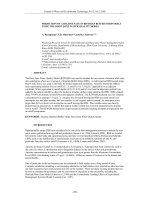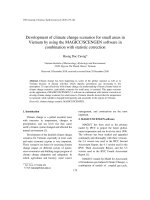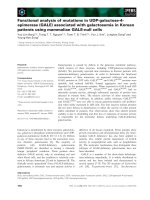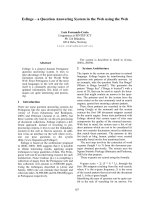liquefaction mitigation in silty soils using stone columns supplemented with wick drains
Bạn đang xem bản rút gọn của tài liệu. Xem và tải ngay bản đầy đủ của tài liệu tại đây (9.35 MB, 366 trang )
LIQUEFACTION MITIGATION IN SILTY SOILS
USING STONE COLUMNS
SUPPLEMENTED WITH WICK DRAINS
BY
THEVACHANDRAN SHENTHAN
December 2005
Dissertation submitted to the
Faculty of the Graduate School of
State University of New York at Buffalo
In partial fulfillment of the requirements for the degree of
Doctor of Philosophy
Department of Civil, Structural, and Environmental Engineering
UMI Number: 3203927
3203927
2006
UMI Microform
Copyright
All rights reserved. This microform edition is protected against
unauthorized copying under Title 17, United States Code.
ProQuest Information and Learning Company
300 North Zeeb Road
P.O. Box 1346
Ann Arbor, MI 48106-1346
by ProQuest Information and Learning Company.
To My Wife Suganya…
ii
ACKNOWLEDGEMENTS
I wish to express my deepest gratitude and sincere thanks to my academic advisor – Dr.
S. Thevanayagam, for his invaluable guidance, inspiration, as well as support and
continuous encouragement, without which this work would not have been possible.
I would also like to thank my dissertation committee members Dr. P.K. Banerjee and Dr.
S. Ahmad, professors at University at Buffalo, and my external review committee
member Dr. G.R. Martin, professor at University of Southern California, for their
continuous guidance and invaluable feedback on my research study.
I would also like to thank graduate student J. Liang, who helped a lot in carrying out
cyclic triaxial tests, and graduate student W. Jia, who helped me in numerical modeling.
Graduate students, T. Kanagalingam and R. Nashed are also thanked for helping me in
generating the field and laboratory tests database, and supporting me through out my
research.
I also need to thank my parents, brother, sisters, my parents in law, sister in law, and
brothers in law. When I began to pursue a higher degree here, SUNY at Buffalo, it was
they who kept on giving me courage and support.
Funding for this research work was provided by FHWA / MCEER Highway Project-094,
and the financial support is greatly appreciated.
Last, but not least, I would like to thank my wife Suganya and my sons Vasheeigaran and
Vagish for their everlasting love, support and encouragement.
iii
Table of Contents
Contents Page
Acknowledgements iii
Table of Contents iv
List of Tables xi
List of Figures xiii
Notations xvii
Abstract xxii
Chapter I Introduction 01
1.0 Introduction 01
1.1 Scope of This Study 03
1.2 Organization of Thesis 07
Chapter II Review of Ground Improvement Techniques 09
2.0 Ground Improvement Techniques to Prevent Liquefaction 09
2.1 Densification Methods 12
2.1.1 Vibro Compaction 12
2.1.2 Vibro Replacement Stone Columns 14
iv
2.1.3 Vibro Concrete Columns 19
2.1.4 Deep Dynamic Compaction 19
2.1.5 Deep Blasting 20
2.1.6 Compaction Grouting 23
2.1.7 Displacement Piles 24
2.2 Drainage Methods 24
2.2.1 Gravel Drains 25
2.2.2 Prefabricated Vertical Drains 28
2.3 Reinforcement Methods 29
2.4 Stabilization Methods by Grouting/Admixtures 30
2.4.1 Jet Grouting 31
2.4.2 Permeation (Chemical) Grouting 33
2.4.3 Intrusion Grouting 34
2.4.4 Electro-Kinetic Injection 34
2.4.5 Deep Soil Mixing 35
2.4.6 Compacted Soil-Cement Mix 36
2.5 Review of Design Methods for Stone Columns 37
2.5.1 Densification 38
2.5.2 Drainage 39
2.5.3 Seismic Shear Stress Redistribution 47
v
2.5.4 Limitations 50
2.5.5 Stone Columns with Supplementary Wick Drains 50
2.6 Summary 52
Chapter III Liquefaction Behavior of Soils 53
3.0 Liquefaction Behavior of Sands and Silty Soils 53
3.1 Cyclic Strength 54
3.2 Pore Pressure Generation Behavior 55
3.3 Post-Liquefaction Pore Pressure Dissipation and Densification 55
3.4 Recent Developments in Understanding Liquefaction
-Behavior of Silty Soils 57
3.4.1 Grain Contact Density Indices 57
3.4.2 Static Liquefaction 59
Chapter IV Laboratory Experimental Study 60
4.0 Experimental Program 60
4.1 Materials and Apparatus 62
4.2 Test Procedure 67
4.2.1 Specimen Preparation 67
4.2.2 Manual Saturation 68
4.2.3 Initializing the GEOCOMP Apparatus 68
4.2.4 Back Pressure Saturation and Consolidation 68
vi
4.2.5 Cyclic Loading 69
4.2.6 Pore Pressure Dissipation and Volumetric Strain 71
4.2.7 Hydraulic Conductivity 71
4.2.8 Data Acquisition and Interpretation 72
4.3 Experimental Errors 73
4.3.1 Accuracy of Measuring Devices 73
4.3.2 Membrane Compliance 74
Chapter V Analysis of Experimental Results 75
5.0 Introduction 75
5.1 Pore Pressure Generation 76
5.2 Compressibility 80
5.3 Coefficient of Consolidation 83
5.4 Post-Liquefaction Densification 89
5.5 Cyclic Strength 94
5.6 Energy Based Approach to Cyclic Resistance 97
5.7 Conclusion 98
Chapter VI Numerical Modeling 99
6.0 Introduction 99
6.1 Stone Column Installation Process 101
6.2 Theoretical Framework 103
vii
6.2.1 Pore Pressure Generation 103
6.2.2 Pore Pressure Dissipation 118
6.2.3 Densification 119
6.3 Numerical Simulation of Stone Column Installation Process 119
6.3.1 Formulation of the Finite Difference
Numerical Scheme 120
6.3.2 Simplification of the Problem and
Boundary Conditions 121
6.3.3 Parametric Study: Stone Columns in Sands & Silts 124
6.3.4 Parametric Study: Composite Stone Columns in
Sands and Silts 129
6.3.5 Effect of Cavity Expansion 138
6.4 Performance of Stone Columns During an Earthquake 141
6.5 Stone Column Installation – Quality Control 142
6.6 Summary 146
Chapter VII Field Study – Stone Column Installation 148
7.0 Introduction 148
7.1 Soil Conditions 148
7.2 Liquefaction and Settlement Analyses 150
7.3 Recommendations 151
viii
7.4 Equipment and Basic Construction Procedure 153
7.5 Instrumentation 154
7.6 Observations 159
7.7 Verification of Numerical Simulations 166
Chapter VIII Design Charts and Design Guidelines 170
8.0 Introduction 170
8.1 Assumptions 170
8.2 Design Charts 172
8.3 Design Guidelines 175
8.4 Sample Design 178
Chapter IX Conclusions and Recommendations 182
9.0 Conclusions 182
9.1 Recommendations 185
References 187
Appendix:
A- Sample Interpretation 202
B- Test Results Summary Table 208
C- Individual Test Summary and Interpretation 212
D- Field Test Data 293
ix
E- SPT – Relative Density Relationships 316
F- Sample Input File Used in the Numerical Simulation 317
G- APPENDIX G: The Program Code in FORTRAN 319
x
List of Tables
Table 1.1 Ground Improvement techniques for Liquefaction Mitigation 2
Table 2.1 Soil Improvement Methods for Liquefaction Mitigation 10
Table 2.2 Selected Vibro Compaction Projects as a Liquefaction Countermeasure 13
Table 2.3 Selected Vibro Replacement Stone Columns
Projects as a Liquefaction Countermeasure 17
Table 2.4 Performance of Sites (Given in Table 2.3) During Earthquakes 18
Table 2.5 Selected Deep Dynamic Compaction
Projects as a Liquefaction Countermeasure 21
Table 2.6 Selected Deep Blasting Projects as a Liquefaction Countermeasure 22
Table 2.7 Selected Compaction Grouting
Projects as a Liquefaction Countermeasure 24
Table 2.8 Selected Gravel Drains Projects as a Liquefaction Countermeasure 26
Table 2.9 Performance of Sites (Given in Table 2.8) During Earthquakes 27
Table 2.10 Selected Jet Grouting Projects as a Liquefaction Countermeasure 32
Table 2.11 Selected Permeation Grouting
Projects as a Liquefaction Countermeasure 34
Table 2.12 Selected Deep Soil Mixing Projects as a Liquefaction Countermeasure 35
Table 4.1 Experimental Program 62
Table 4.2 Index Properties 63
Table 4.3 Accuracy of Measuring Devices 73
xi
Table 5.1 Anticipated Post-Densification Cyclic Strength 95
Table 6.1 Classification of Earth Materials by Attenuation Coefficient 105
Table 6.2 Vibratory Probe Parameters 125
Table 6.3 Simulation Parameters 125
Table 6.4 Comparison of Densification Processes using
Stone Column in Sand in Sand and Silt 132
Table 6.5 Simulation Parameters – Cavity Expansion 140
xii
List of Figures
Fig. 1.1 Research Tasks 6
Fig. 2.1 Applicable Grain Size Ranges for Different Stabilization Methods 12
Fig. 2.2 Typical Procedure for Vibro Compaction 13
Fig. 2.3 Vibro Replacement Stone Column Technique 14
Fig. 2.4 Range of Soils Treated by Vibro Stone Columns 15
Fig. 2.5 Schematic Diagram Showing Dynamic Compaction 20
Fig. 2.6 Schematic Diagram Showing Compaction Grouting 23
Fig. 2.7 Typical Wick Drain Installation Process 29
Fig. 2.8 Schematic Diagrams of (a) Jet, (b) Permeation, and
(c) Intrusion Grouting 31
Fig. 2.9 Prediction of Post-SPT Based on Pre-SPT and A
r
39
Fig. 2.10 Arrangement of Stone Column System 41
Fig. 2.11 Relationship between Greatest Pore Pressure Ratio (r
g
)
and Drain System Parameters 43
Fig. 2.12 A Part of the Stone Column Design Chart Developed by Onoue (1998) 46
Fig. 2.13 Required Area Replacement Ratio for Liquefaction Reduction by
Stress Redistribution to achieve a Post-Treatment FS=1 48
Fig. 3.1 Scematic Diagrams of Monotonic Triaxial Tests 59
Fig. 4.1 Particle Size Distribution of Ottawa Sand-Silt Mixtures 64
Fig. 4.2 Particle Size Distribution of Natural Silts Tested 64
xiii
Fig. 4.3 GEOCOMP Triaxial Apparatus 65
Fig. 4.4 Pressure Panel 66
Fig. 4.5 Equipment Used for Specimen Preparation 66
Fig. 4.6 Schematic Diagram of the Experimental Setup 70
Fig. 5.1 Pore Pressure Generation Data for Sands and Clayey Silts
Reported in Literature 76
Fig. 5.2 Pore Water Pressure Generation Data (This Study) Along with
Those from Literature 78
Fig. 5.3 Pre- and Post-Liquefaction Consolidation 80
Fig. 5.4 Pre- and Post-Liquefaction Volume Compressibility 82
Fig. 5.5 Back Calculation of c
v
85
Fig. 5.6 Pre- and Post-Liquefaction Coefficient of Consolidation 87
Fig. 5.7 Normalized c
v
Values of Artificial Soil Mixes Tested 88
Fig. 5.8 Comparison of Dissipation Times for Sand and Silt 88
Fig. 5.9 Post-Liquefaction Volume Change Data 90
Fig. 5.10 Volumetric strain Due to Remolding of Soil Following Liquefaction 92
Fig. 5.11 Volumetric Strain of Sand and Sandy silts vs. (a) Relative Density
(b) Eq. Rela. Density (FC<FC
th
) and (c) Eq. Rela. Density (FC>FC
th
) 93
Fig. 5.12 Void Ratio and Equivalent Void Ratios vs. No. of Cycles 96
Fig. 5.13 Contact Density Indices vs. E
L
97
Fig. 6.1 Vibro-Stone Columns and Composite Vibro-Stone Column 100
Fig. 6.2 The Vibratory Probe 102
xiv
Fig. 6.3 Radiation of Vibratory Energy - Schematic 107
Fig. 6.4 Defin. of Radii Used in the Analysis, and Stress States around the Probe 109
Fig. 6.5 CP vs. Equivalent Relative Density 117
Fig.6.6 Composite Stone Column Layout 122
Fig.6.7 Typical Mesh for the Finite Difference Scheme 123
Fig. 6.8 The Intersection of Two Interfaces 124
Fig. 6.9 Vibro-Stone Column Simulation Results 126
Fig. 6.10 Regression Design Curves (Baez 1995) 126
Fig. 6.11 Pore Pressure Changes within the Soil during Stone Column Installation 127
Fig. 6.12 Effect of Hydraulic Conductivity of Soil on the
Post – Improvement Density 129
Fig. 6.13 Effect of Wick Drains in Densification during Stone Column Installation 130
Fig. 6.14 Simulation Results 139
Fig. 6.15 Effect of Cavity Expansion on Post-Improvement Soil Density 141
Fig. 6.16 Effect of I
r
on r
u
Induced by Cavity Expansion 141
Fig. 6.17 Effective Friction Angle vs. Equivalent Relative Density 143
Fig. 6.18 Comparison of Current Readings: Sand and Silt 145
Fig. 7.1 Typical Cross Section of the Site, Marina del Rey, CA 149
Fig. 7.2 Post-Improvement Site Layout: Schematic 152
Fig. 7.3 The Vibratory Probe 154
Fig. 7.4a Site Layout and Instrumentation locations (A, B and C) – Schematic 155
Fig. 7.4b Schematic Profiles through Instrumentation Locations A and B 155
Fig. 7.5 Seismic Piezocone Pushed at Location A 156
xv
Fig. 7.6 Seismic Detector Response Curve for the Geophone Used in the Project 158
Fig. 7.7 Pore Pressure Responses at A and B 160
Fig. 7.8 Pore Pressure Response at A Corresponding to Probe Depth 161
Fig. 7.9 Pore Pressure Response at C Corresponding to Probe Depth 161
Fig. 7.10 Pore Pressure Response at A Corresponding to Probe Distance 162
Fig. 7.11 Pore Pressure Response at C Corresponding to Probe Distance 162
Fig. 7.12 Absolute Radial Acceleration at A Corresponding to Probe Distance 164
Fig. 7.13 Vertical Acceleration at A Corresponding to Probe Distance 164
Fig. 7.14 Absolute Radial Acceleration at C Corresponding to Probe Distance 165
Fig. 7.15 Vertical Acceleration at C Corresponding to Probe Distance 165
Fig. 7.16 Peak Current Corresponding to Probe Depth 166
Fig. 7.17 Comparison of Simulated and Measured Pore pressures 167
Fig. 7.18 Pre- and Post-Improvement CPT Profiles 168
Fig. 7.19 Comparison of the Simulated and Measured Post-Improvement Densities169
Fig. 7.20 Comparison of the Simulated and Measured Post-Improvement SPT 169
Fig. 8.1 Composite Vibro-Stone Columns – Design Charts based on Soil Densities173
Fig. 8.2 Composite Vibro-Stone Columns – Design Charts based on SPT 174
Fig. 8.3 Stone Column Design Procedure 177
Fig. 8.4 Pre- and Minimum Required Post-improvement (N
1
)
60cs
Profile 180
xvi
Notations
A = Amplitude of ground vibration
A
e
= Tributary area
A
r
= Area replacement ratio
a = Stone column radius
b = Factor representing influence of fine grains; One half of stone column spacing
C
c
= Coefficient of concavity
C
h
= Coefficient of consolidation in horizontal direction
CP = Collapse potential
CSR = Cyclic stress ratio
C
u
= Coefficient of uniformity
C
v
= Coefficient of consolidation; Coefficient of consolidation in vertical direction
D = Diameter of causer grains; Stone column diameter
D
50
= 50% passing diameter
D
r
= Relative density
(D
r,c
)
eq
= Equivalent relative density (FC<FC
th
)
(D
r,f
)
eq
= Equivalent relative density (FC<FC
th
)
d = Diameter of finer grains; depth below ground
d
e
= Effective diameter
d
w
= Stone column diameter
E = Young’s modulus
E
c
= Cumulative energy loss per unit volume of soil
E
L
= energy per unit volume required to cause liquefaction
xvii
e = Global void ratio
e
c
= Intergranular void ratio
(e
c
)
eq
= Equivalent intergranular void ratio
e
f
= Interfine void ratio
(e
f
)
eq
= Equivalent interfine void ratio
e
max
= Maximum void ratio
e
max,hf
= Maximum void ratio of host fines
e
max,hs
= Maximum void ratio of host sand
e
min
= Minimum void ratio
FC = Percentage fines content
FC
th
= Threshold fines content
fc = FC/100
G
r
= Shear modulus ratio
G
s
= Shear modulus of soil
G
sc
= Shear modulus of stone columns
H = Depth of stone columns
H
dr
= Length of longest drainage path
I
r
= Rigidity Index (G/S
u
)
k = Hydraulic conductivity
k
h
= Hydraulic conductivity of soil in horizontal direction
k
s
= Hydraulic conductivity of soil
k
w
= Hydraulic conductivity of gravel wells
LL = Liquid limit
xviii
L
w
= Coefficient of well resistance
m = A coefficient (0<m<1)
m
v
= Volume compressibility of soil
N = Number of stress cycles
N
1
= Normalized SPT
(N
1
)
60
= Corrected SPT blow counts
(N
1
)
60cs
= Normalized clean sand equivalent SPT
N
eq
= Equivalent number of cycles
N
L
= Number of cycles required for initial liquefaction (5% double ampl. Ax. Strain)
N
q
= Normalized effective cone tip resistance (q
c
’/σ
v0
’)
P
0
= power rating of the vibratory probe
PI = Plasticity index
q
c
’ = Effective cone tip resistance
q
c1N
= Normalized CPT
R
d
= Size disparity ratio (D/d)
R
e
= Cavity Radius during expansion
r = Radial distance from the center of stone columns
(r
u
)
avg
= Average excess pore pressure ratio
(r
u
)
max
= The greatest excess pore pressure ratio
max
_
)(
u
r
= The greatest average excess pore pressure ratio
r
s
= Spacing ratio
r
u
= Excess pore pressure ratio (∆u
sh
/σ’
c
)
r
w
= Well radius
xix
S = Normalized unit membrane compliance
S
u
= Undrained shear strength
T
bd
= Time factor used in the numerical analysis
T
v
= Time factor
t = Time
t
d
= Duration of strong ground shaking
u = Pore pressure, Excess pore pressure
u
g
= Excess pore pressure generated by ground motion or cavity expansion
u
sh
= Shear induced excess pore pressure
W = Energy per unit time passing through a unit area of spherical surface at radius r
W
o
= η
0
P
0
w = Energy loss per unit time per unit volume of soil at distance r
Z = Vertical distance from the surface
Z
dr
= Vertical nearest distance to the drainage path
ψ
e
= Pressure at the cavity wall
∆σ
z
= Change in vertical total stress due to applied load
α = Constant, Coefficient of attenuation
β = Constant
ε
a
= Axial strain
ε
r
= Radial strain
ε
v
= Volumetric strain
ε
θ
= Angular strain
γ = Shear strain
xx
γ
w
= Unit weight of water
η
0
= probe efficiency
ν = Poisson’s ratio
σ’
vo
= Initial effective confining stress
σ
c
= Confining pressure
σ
h0
= Insitu horizontal stress
σ
r
= Stress in radial direction
σ
θ
= Stress in angular direction
τ = Shear stress
τ
s
= Shear stress experienced by soil
ξ = Displacement
xxi
ABSTRACT
Vibro replacement stone columns are in use to mitigate liquefaction hazards in sandy
soils for almost three decades. There are three mechanisms that help reduce liquefaction
potential of a sandy soil improved using stone columns. During stone column installation
sandy soils densify due to installation vibration. Further, the stiffness of the composite
improved soil increases leading to a reduction in cyclic shear stress induced on the soil
surrounding the stone columns during earthquakes. In addition, pore pressures generated
in the soil during earthquakes are quickly dissipated through the highly permeable stone
columns. These combined mechanisms reduce the liquefaction potential of the improved
soil. Sandy soil sites improved using stone columns have performed well during
earthquakes. However, its effectiveness in silty soils is limited. Recent case histories
show stone columns supplemented with wick drains work well in such soils. This study
focuses on three aspects: (i) examining the reasons for the sub-performance of stone
columns in silty soils, identifying key soil parameters that hinder the effectiveness of
stone columns, and developing means to improve the effectiveness of this method in silty
soils including provision of supplementary wick drains, (ii) developing a numerical
model to simulate stone column installation with and without wick drains, and
qualitatively evaluate the degree of ground improvement, and (iii) verifying the
numerical simulation results using case histories and field experimental studies, and
developing modified design charts and guidelines for designing stone columns with and
without wick drains to improve sands and silty soils.
xxii
Pore pressure generation, post-liquefaction dissipation, and densification characteristics
of an artificial silty soil and three natural silty soils were experimentally studied and
compared with sand. A careful analysis of such data indicates that liquefaction
characteristics of silty soils and sands are not very different when compared using grain
contact density indices as the basis for comparison. However, post-liquefaction
dissipation characteristics are very much dependent on grain size characteristics. Low
coefficient of consolidation associated with silty soils precludes faster pore pressure
dissipation during stone column installation and therefore hinders densification around
the stone columns during installation. It also hinders drainage during earthquakes. This
appears to be the primary reason for the lack of effectiveness of stone columns in silty
soils. Numerical studies of pore pressure behavior of silty and sandy soils support this
view.
Based on the experimental results, a numerical model was developed to simulate the
stone column installation process. During installation, pore pressure generated due to the
vibratory energy imparted into the surrounding ground was estimated, and the ground
densification associated with pore pressure dissipation was calculated. Several
simulations were done for sands and silty soils with varying initial conditions improved
using stone columns with and without wick drains. The model was fine tuned and tested
using case studies and field measurements.
Design charts and design guidelines that were developed based on the extensive
experimental and numerical study are presented. Recommendations for improving the
stone column design methodology, and for further research in this subject are presented
as well.
xxiii
Chapter 1
INTRODUCTION
1.0 Introduction
Saturated, loose granular deposits, when subjected to earthquake loading,
experience a rapid pore pressure increase and temporary loss of strength. This may lead
to liquefaction, a stage, when soil looses almost all the strength and behaves like a liquid.
Such a stage leads to lateral spreading of the gently sloping ground, densification and
vertical ground settlements, and slope instability. Case histories indicate that soil types
prone to liquefaction are loose sand, silty sands/sandy silts containing mostly non-plastic
silt, and gravel. Only rarely clays, except for sensitive clays, do experience loss of
strength. Saturated alluvial granular deposits prone to liquefaction are very commonly
found particularly near river-crossings and water-front harbor facilities and have caused
major damage to transportation structures in almost every major earthquake. During the
1964 great Alaskan earthquake many highway and railway bridges were collapsed
beyond repair mainly due to liquefaction and related ground deformations (Bartlett and
Youd, 1992). Buckle (1995) reported of the distress to the bridge superstructure and
collapse of several spans caused by lateral movement of several bridge piers due to lateral
spread of the ground along the manmade waterfront area in Kobe. Similar waterfront and
transportation facility damage has been observed during the most recent Taiwan Chi-Chi
1









